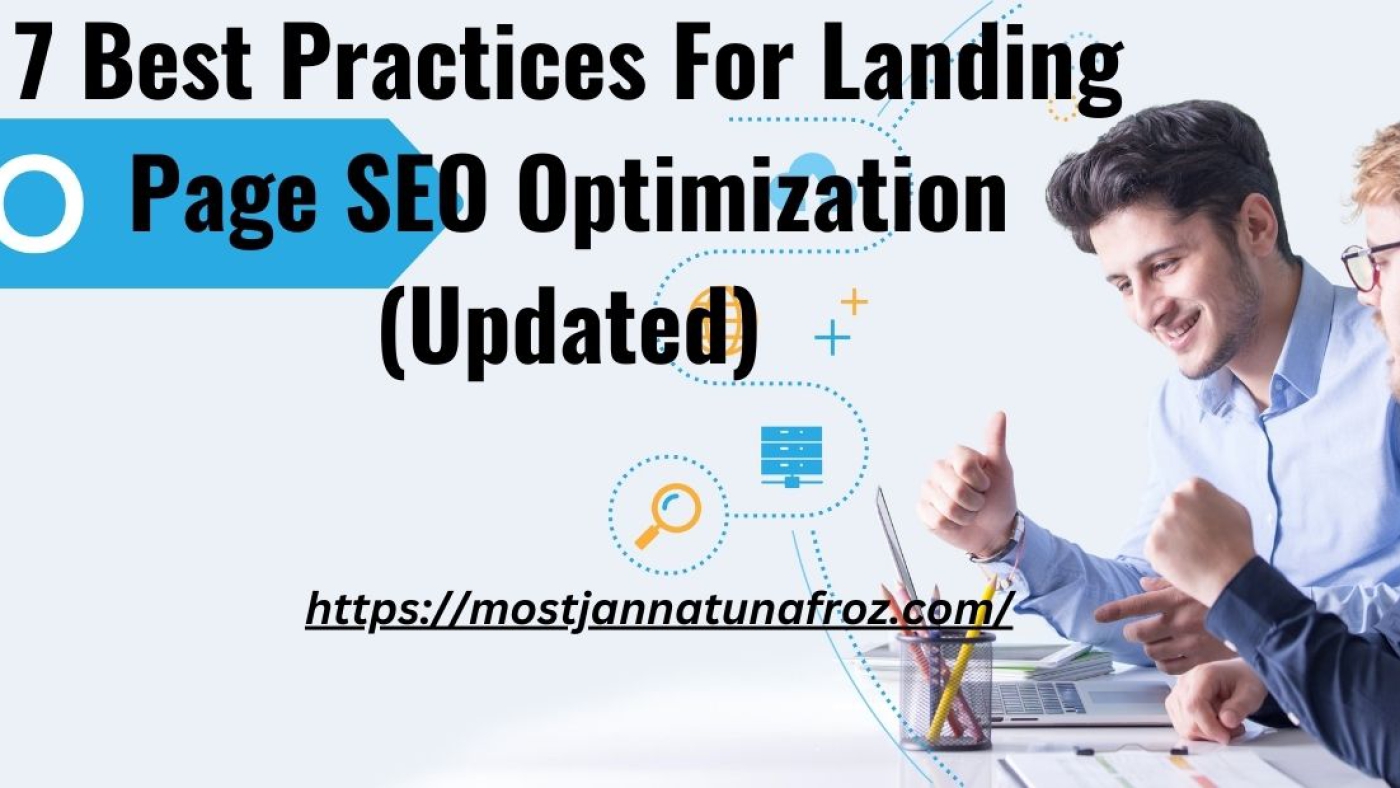Mastering landing page optimization best practices can dramatically improve conversion rates by creating a seamless, user-focused experience that guides visitors toward taking desired actions.
Creating effective landing pages is essential for driving traffic, capturing leads, and converting visitors into customers. However, more than just having a beautiful and compelling landing page is required. To maximize its performance, you must also optimize it for search engines.
This article will explore the seven best practices for optimising landing page SEO, updated for the latest trends and techniques, ensuring your pages attract visitors and convert them into loyal customers.
What Is Landing Page SEO Optimization
Before diving into the best practices, let’s clarify what landing page SEO optimization is. It refers to enhancing a landing page to improve its visibility in search engine results pages (SERPs) and provide a better user experience.
This involves keyword research, content optimization, technical SEO, and improving conversion rates. A well-optimized landing page will rank higher in search results, driving more organic traffic and increasing conversion rates.
1. Conduct Thorough Keyword Research
Keyword research is the foundation of any successful SEO strategy. Understanding what your target audience is searching for allows you to create content that meets their needs.
Steps for Effective Keyword Research
- Use Keyword Research Tools: Tools like Google Keyword Planner, Ahrefs, and SEMrush can help you identify relevant keywords with high search volumes and low competition. Look for both primary and long-tail keywords that match the intent of your landing page.
- Analyze Competitor Keywords: Check which keywords your competitors are ranking for. This can give you insights into what works in your niche and help you find opportunities to target less competitive keywords.
- Consider Search Intent: Understand the different types of search intent—informational, navigational, and transactional. Your landing page should align with the intent behind the keywords you choose. For example, if you’re offering a product, ensure the landing page targets transactional keywords that indicate the user is ready to buy.
Example
If your landing page concerns a new fitness program, keywords like “best fitness programs for weight loss” or “30-day fitness challenge” can be effective. Consider also including long-tail keywords like “home workouts for beginners” to attract specific search queries.
2. Create High-Quality, Engaging Content for Landing Page Optimization
Once you have your keywords, it’s time to create content that engages your visitors and keeps them on your page.
Elements of Quality Content
- Compelling Headlines: Your headline should be clear and engaging. It’s the first thing users see and should include your primary keyword. A well-crafted headline can significantly improve your click-through rate (CTR).
- Informative and Relevant Text: The body content should provide valuable information that addresses your audience’s needs and questions. Incorporate keywords naturally into your content, but avoid keyword stuffing. Aim for a keyword density of around 1-2%.
- Visual Content: Use images, infographics, and videos to make your landing page more visually appealing. Visuals help explain complex concepts and keep users engaged. Make sure to optimize images with alt text that includes relevant keywords.
- Bullet Points and Short Paragraphs: Break your content into digestible chunks. Use bullet points and short paragraphs to make it easier for readers to scan the content.
Example
For a landing page promoting a fitness program, include:
- Sections on the program’s benefits.
- Success stories from previous participants.
- An FAQ section addressing common questions.
3. Optimize Page Titles and Meta Descriptions for Landing Page
Page titles and meta descriptions are crucial for both SEO and user experience. They appear in search results and can significantly impact your CTR.
Best Practices for Titles and Meta Descriptions
- Include Keywords: The page title and meta description should include your primary keyword. This helps search engines understand the content and improves relevancy.
- Keep It Concise: Aim for a title length of 50-60 characters and a meta description of 150-160 characters. This ensures that they display correctly in search results without being cut off.
- Write Compelling Copy: The title and meta description should entice users to click. Use action-oriented language and clearly state the value they will get from your page.
Example
Title: “Transform Your Body with Our 30-Day Fitness Challenge”
Meta Description: “Join our 30-day fitness challenge and achieve your weight loss goals! Discover workout plans, nutrition tips, and success stories from real participants.”
4. Ensure Mobile Optimization
With over half of all web traffic from mobile devices, your landing pages must be mobile-friendly. Google also uses mobile-first indexing, meaning it prioritizes the mobile version of your site for ranking.
Tips for Mobile Optimization
- Responsive Design: Use responsive web design to ensure your landing page adapts to various screen sizes. Test how your page looks on different devices to ensure a seamless experience for all users.
- Fast Loading Times: Mobile users are often on the go, and they expect pages to load quickly. Use tools like Google PageSpeed Insights to analyze and improve loading times. Optimize images and reduce the use of heavy scripts.
- Simplified Navigation: Make navigating your landing page easy for mobile users. Use large buttons and a clear, concise layout to guide users toward the desired action.
Example
If your landing page has a form for users to sign up for a fitness challenge, ensure the form fields are easy to fill out on a mobile device. Keep the form short to encourage submissions.
5. Improve Page Load Speed
Page load speed is a critical factor in both SEO and user experience. A slow-loading landing page can lead to high bounce rates and negatively affect your search rankings.
How to Improve Load Speed
- Optimize Images: Compress images to reduce file sizes without sacrificing quality. Use formats like WebP for better compression rates.
- Minimize HTTP Requests: Reduce the number of elements on your page (such as scripts, stylesheets, and images) to minimize the number of HTTP requests made when loading the page.
- Leverage Browser Caching: Implement caching to store frequently accessed files on users’ devices. This speeds up load times for returning visitors.
Example
You can use tools like GTmetrix or Pingdom to analyze the load speed of your landing page. These tools provide insights and recommendations for improving performance.
6. On-Page SEO Techniques for Landing Page Optimization Best Practices
On-page SEO involves optimizing various elements on your landing page to enhance its visibility and relevancy to search engines.
Key On-Page Elements to Optimize
- Header Tags: Use header tags (H1, H2, H3) to structure your content effectively. The H1 tag should contain your primary keyword, while the H2 and H3 tags can be used for subheadings and sections within the content.
- Image Alt Text: Use descriptive alt text for all images on your landing page. This helps search engines understand the content of your images and improves accessibility for users with visual impairments.
- Internal Linking: Link to other relevant pages on your website. This helps with SEO and keeps users engaged by guiding them to related content.
- Schema Markup: Implement schema markup to provide search engines with more information about your landing page. This can enhance your search listings with rich snippets, improving CTR.
Example
For a fitness program landing page, you might use H2 tags for sections like “Program Benefits,” “Success Stories,” and “How to Join.” This structure helps users and search engines better understand your content.
7. Leverage Social Proof and Trust Signals
Including social proof and trust signals on your landing page can enhance credibility and encourage visitors to convert.
Types of Social Proof and Trust Signals
- Testimonials: Showcase testimonials from satisfied customers who have benefited from your product or service. Positive reviews can significantly influence potential customers’ decisions.
- Case Studies: Share detailed case studies highlighting previous participants’ success in your program. Include metrics, before-and-after comparisons, and real-life stories.
- Trust Badges: If applicable, display trust badges, security certifications, or affiliations with reputable organizations. These can reassure users that their information is safe.
- Media Mentions: If your program has been featured in reputable media outlets, include logos or snippets of these mentions to build trust.
Example
“I lost 15 pounds in 30 days! The workouts were challenging but fun, and the community support kept me motivated.” – Jane Doe, Happy Participant.
Conclusion
Optimizing your landing page for SEO is crucial for driving organic traffic, improving visibility, and increasing conversions. By following these seven best practices for optimising landing page SEO, you can create a landing page that ranks well in search engines and provides a seamless and engaging experience for your visitors.
As SEO evolves, staying updated on the latest trends and best practices is vital for maintaining your competitive edge. Regularly monitor your landing page performance using tools like Google Analytics and Google Search Console, and be prepared to make adjustments based on user behaviour and search trends.
By implementing these strategies, you can maximize the effectiveness of your landing pages and achieve your business goals, whether generating leads, selling products, or promoting services. Remember, a well-optimized landing page is a powerful tool that can significantly impact your online success.


[…] Example: A SaaS company used AI heatmaps to optimize their landing pages. By tweaking the layout based on user behaviour, they increased conversions by […]